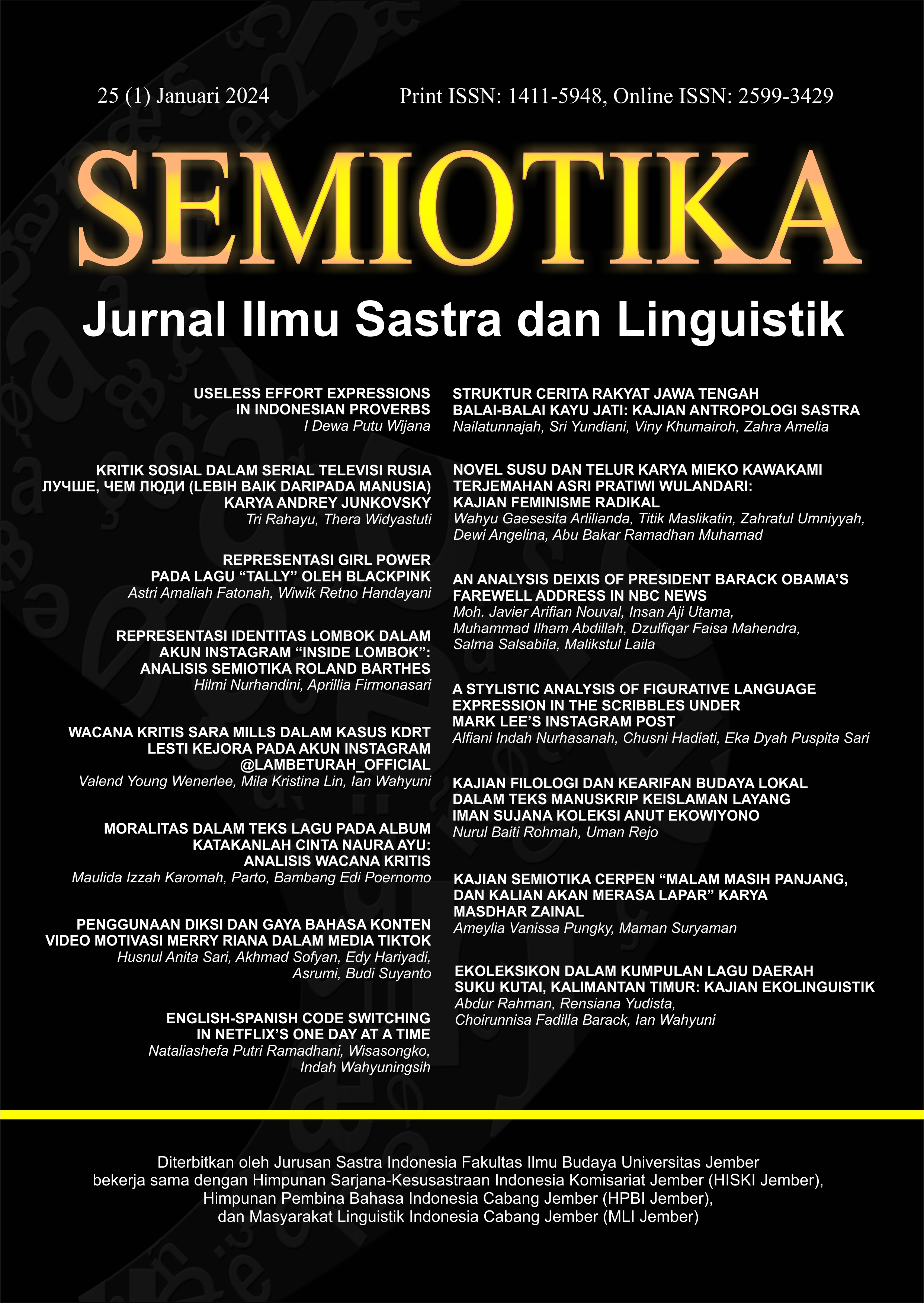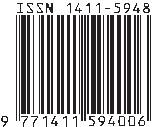PENGGUNAAN DIKSI DAN GAYA BAHASA KONTEN VIDEO MOTIVASI MERRY RIANA DALAM MEDIA TIKTOK
Abstract
Merry Riana's motivational video content contains encouragement to build an optimistic attitude when you experience failure in achieving your goals, are disappointed by your partner, receive negative comments from other people and when you want to choose a potential life partner. The purpose of this study is to describe the use of diction and motivational language style of Merry Riana in TikTok media using semantic and pragmatic studies. This research is a text-based descriptive qualitative research, using the referential equivalent method to analyze the meaning and using the interpretation method to reveal the purpose of motivation based on related contexts. The results of this study indicate that Merry Riana uses greeting diction, synonym diction, special diction, general diction, foreign language diction, borrowed word diction, popular diction, scientific diction and conversational diction. The diction that is widely used is the diction of a foreign language, namely English. The style of language found in this study uses a style of language based on sentence structure of 5 types and a style of language based on the direct or indirect meaning of 9 types. The style of language that is most widely used is the style of language based on whether the meaning is direct or not, namely, climax. The use of diction and language style functions to: 1) encourage listeners when they feel hopeless; (2) influencing and convincing the listeners with the motivational delivered; and (3) provide an interesting effect on motivational speech patterns.
References
Chaer, A. 1998. Tata Bahasa Praktik Bahasa Indonesia. Jakarta: PT Bharata Karya Aksa.
Indira, G.P. 2020. “Tindak Tutur Ilokusi dalam Dialog Film Merry Riana: Mimpi Sejuta Dolar”. Tidak Diterbitkan. Skripsi. Surabaya: Fakultas Ilmu Budaya, Universitas Airlangga.
Kementerian Pendidikan, Kebudayaan, Riset dan Teknologi Republik Indonesia. 2016. Kamus Besar Bahasa Indonesia. [Online]. Diakses 2 November 2022. Tersedia di: https://kbbi.kemdikbud.go.id/.
Keraf, G. 1991. Diksi dan Gaya Bahasa. Jakarta: PT. Gramedia Pustaka Utama.
Mahmudah, S.M. & Rahayu, M. 2020. “Pengelolaan Konten Media Sosial Korporat pada Instagram Sebuah Pusat Perbelanjaan. Jurnal Komunikasi Nusantara. Universitas Mercu Buana.
Nasaliya, R.A. 2022. “Representasi Perjuangan Perempuan dalam Film Kartini, 3 Srikandi, dan Merry Riana Sejuta Dolar: Analisis Semiotik”. Jurnal Penelitian Bahasa dan Sastra Indonesia.
Nurgrahani, F. 2014. Metode Penelitian Kualitatif dalam Penelitian Pendidikan Bahasa. Solo: Cakra Books.
Nurohman, D.A. 2021. Konten Kreator: Cara Kreatif Menghasilkan Uang dengan Menjadi Blogger, Youtuber, atau Tiktoker. Bengkulu: Elmarkazi.
Pratama, K.R. 2022. Diakses pada 6 Oktober 2022. Tersedia di: https://tekno.kompas.com/read/2022/01/03/08070077/tiktok-diprediksi-jadi-medsos-terbesar-ketiga-pada-2022?page=all.
Purwo, B.K. 1984. Deiksis dalam Bahasa Indonesia. Jakarta: PN Balai Pustaka.
Ridwan, M.H. & Azizah, L. 2022. “Analisis Struktur Percakapan Merry Riana dan Narasumber pada Gelar Wicara Zero to Hero”. Jurnal Kajian Ilmu Pendidikan Bahasa dan Sastra Indonesia, 2 (1).
Rifada, I.M. 2021. “Nilai-Nilai Karakter dalam Segmen Spoken Word pada Channel Youtube Merry Riana”. Skripsi. Malang: Fakultas Keguruan dan Ilmu Pendidikan, Universitas Muhammadiyah Malang.
Septiani, M. 2018. “Representasi Pesan Moral dalam Film Merry Riana Mimpi Sejuta Dolar”. Skripsi. Jakarta: Fakultas Ilmu Dakwah dan Ilmu Komunikasi, Universitas Islam Negeri Syarif Hidayatullah Jakarta.
Sudaryanto. 1993. Metode dan Aneka Teknik Analisis Bahasa. Yogyakarta: Duta Wacana University Press.
Zamri, N.N. & Aini, Z. 2021. “Retorik dalam Dakwah Nik Abdul Aziz Nik Mat”. Jurnal Pengajian Islam. Vol. 14. Malaysia: International Islamic University College Selangor.

This work is licensed under a Creative Commons Attribution-ShareAlike 4.0 International License.
SEMIOTIKA has CC-BY-SA or an equivalent license as the optimal license for the publication, distribution, use, and reuse of scholarly work. Authors who publish with this journal retain copyright and grant the journal right of first publication with the work simultaneously licensed under a Creative Commons Attribution-ShareAlike 4.0 International License that allows others to share the work with an acknowledgment of the work's authorship and initial publication in this journal.
Attribution-ShareAlike
CC BY-SA










